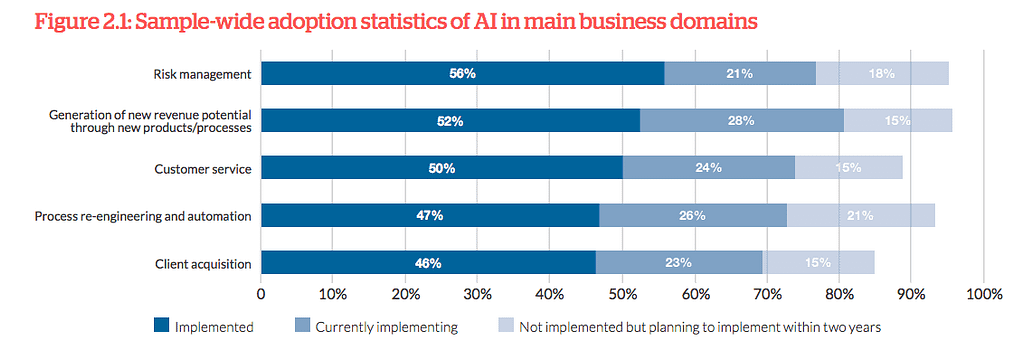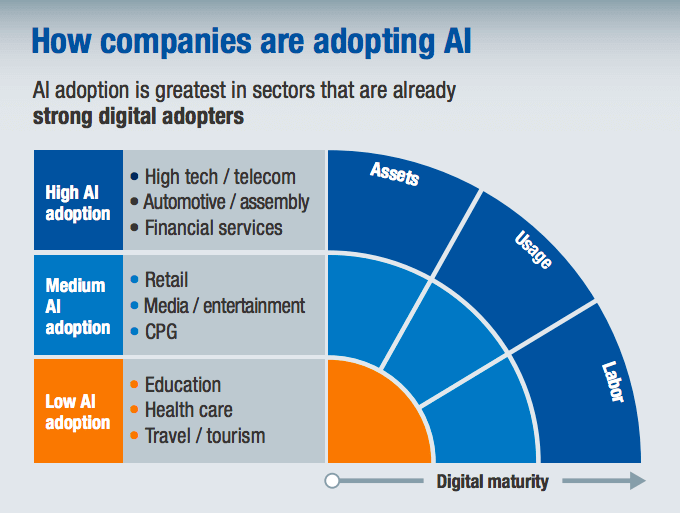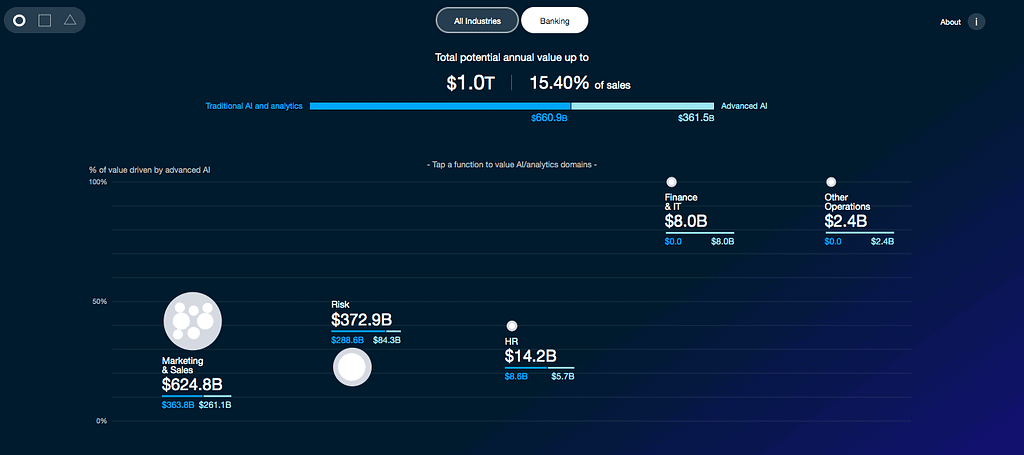AI & finance: a match made in heaven?
The finance sector was among the first ones to adopt artificial intelligence technologies. Just think about the trading floor – what used to be a place for all the brokers and finance experts (yes, we’re talking Wall Street) is now a room full of computers with just a few people around. In 2015, Business Insider reported that Goldman Sachs employed around nine thousand programmers and engineers – out of 33 thousand full-time employees in total. Finance and banking have become very tech-savvy, where tech skills are no more just nice to have, they’re a must for many professions. Finance has a lot of potential in terms of AI applications, some of which are already in place today. Today, we’ll have a look at some of the most common – and successful – use cases of machine learning algorithms for finance and banking.
In a recent study on AI in financial services conducted by World Economic Forum, a significant number of executives from 151 financial institutions in 33 countries say that within 2 years, they expect to become mass adopters of AI and expect AI to become an essential business driver across the financial industry, as reported by Forbes.
The same paper shows some interesting insights about the financial sector:
- 85% of companies that took part in the survey are currently using some form of AI
- 77% of respondents expect that AI will become essential to their business within 2 years
- 50% expect a big competitive threat from tech companies leveraging AI to enter the financial services sector.
Why is AI used in finance?
The primary – the only right in my opinion – reason to adopt any AI technology is for the money. Either cutting down on costs or increasing revenue by boosting sales etc. – it’s about solving an existing problem, not getting AI for the sake of having AI.
With artificial intelligence, finance service providers can be used for:
- risk management
- generating new revenue potential
- customer service
- process re-engineering and automation
- customer acquisition.

World Economic Forum, Transforming Paradigms: A Global AI in Financial Services Survey
Since the finance sector was an early adopter of AI technologies, there are already multiple use cases that have proven to bring the desired results. Leading AI adopters, including the verticals of tech, telecom, and financial services, tend to adopt multiple technologies across multiple functions.

McKinsey Global Institute, Artificial Intelligence. The Next Digital Frontier
Use cases of AI in finance
As presented above, financial institutions have been investing in AI technologies for a while now and are already using AI across various functions. While the past AI efforts were largely focused on automating many of the labor-intensive and time-consuming tasks, boosting efficiency, and eliminating avoidable errors, financial services providers then could move on to boosting the efficiency of the most expensive experts – an area in which AI will prove its impact in the future.
But we’re not talking about the past nor the future of finance – let’s focus on those use cases that are the most successful today.
Underwriting and risk management
Traditional models of underwriting analyze a handful of credit attributes. AI can go further than that. AI-powered underwriting models can analyze numerous data points from the bank’s database and third parties, such as credit bureaus, to accurately assess credit risk.
Risk management functions are essential to the financial sector and not only in terms of credit risk, detecting fraud is also a crucial function. Tasks that would be highly time-consuming, or sometimes even undoable, to the employees can now be given to machines that handle the data with care (given rules to follow, not by AI’s own instinct), reduce error, and spot anomalies that could otherwise be missed.
Customer service
Artificial intelligence for customer service has already been covered in some of our previous articles like How does artificial intelligence improve customer service. Financial institutions often use conversational AI to assist their customers. Chatbots, or AI-powered assistants, are available 24/7, provide responses fast, and are able to deal with a large number of customer queries. A chatbot like that can answer the customer’s questions or perform actions triggered by specific commands, e.g. to check account balance.
In 2017, BNY Mellon placed more than 20 bots in production to automate processes ranging from back-office to customer service. Reuters reports:
The bank estimates that its funds transfer bots alone are saving it $300,000 annually, by cutting down the time its employees need to spend on identifying and dealing with data mistakes and accelerating payments processing.
Personalization and recommendations
With more and more customers using financial services primarily online, companies are able to collect more data about users’ behaviors, preferences, and needs. This information can be used to personalize customer experience – if we know that John Doe has just started saving some money, we can suggest opening a dedicated savings account or investing a part of his money. What’s more, financial institutions can educate their customers – showing them the options they have and teaching them to manage their personal budgets efficiently. Recommendations of the right products or services can generate upsells (=more profit), at the same time contributing to higher customer satisfaction.
Read also: What are the things you must consider before implementing AI
Potential for AI in finance and banking
These are only chosen common use cases of AI in financial services – and many institutions implement AI in more than one function. The use of AI in risk management, underwriting, customer service or recommendations is popular – and it’s something that customers are already used to. There are other ways to implement AI, though, and what’s important to remember is that AI should be applied to a specific business problem with a goal to solve it, which includes a strategic approach with defining success and failure criteria and KPIs.

As presented on the illustration above, every department within a financial institution can benefit from AI: human resources can use it to increase employee retention and customize career paths for their teams, sales can contact the right people with the right offer, reducing churn and boosting customer loyalty, marketing can target people with campaigns of the most appropriate services. There are a plethora of use cases, the majority already tried out by many companies and validated. The total potential annual value of AI in banking is estimated at $1T (in words: one TRILLION dollars!), with the main areas driving value being marketing & sales, risk, HR, and finance & IT. This shows that AI is only getting started and there’s still more it can do for the financial sector as well as for business in general.
Learn how to use predictive analytics to drive business results and revenue
